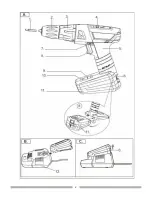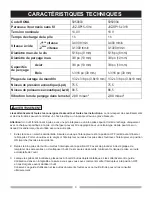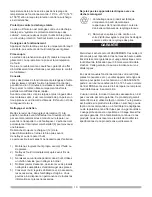
Battery tool use and care
1.
Recharge your tool's battery only with the charger
specified by the manufacturer.
A charger that is
suitable for one type of battery pack may create a risk
of fire when used with another battery pack.
2.
Use power tools only with their specifically
designated battery packs.
Use of any other battery
packs may create a risk of injury and fire.
3.
When battery pack is not in use, keep it away
from metal objects, like paper clips, coins,
keys, nails, screws or other small metal objects,
which can make a connection from one terminal
to another.
Shorting the battery terminals together
may cause burns or a fire.
4.
Under abusive conditions, liquid may be ejected
from the battery; avoid contact. If contact
accidentally occurs, flush with water. If liquid
contacts eyes, additionally seek medical help.
Liquid ejected from the battery may cause irritation
or burns.
Service
1.
Have your power tool serviced by a qualified
repair person using only identical replacement
parts.
This will ensure that the safety of the power
tool is maintained.
1)
Secure the workpiece.
A workpiece clamped with
clamping devices or in a vice is held more secure
than by hand.
2)
Do not work with materials containing asbestos.
Asbestos is considered carcinogenic.
3)
Take protective measures when potentially harmful
dust (combustible or explosive) can develop
during working .
Example: Some dusts
are regarded as carcinogenic. Wear a dust mask and
work with dust/chip extraction when connectable.
4)
Keep your workplace clean.
Certain blends of
materials are particularly dangerous. Dust form light
alloys can burn or explode.
5)
Always wait until the tool has come to a complete
stop before placing it down.
The inserted bit can
jam and lead to loss of control over the power tool.
6)
Before any work on the tool (e.g., maintenance,
bit change, etc.) as well as during transport and
storage, set the rotational direction switch to the
centre position.
Unintentional actuation of the On/Off
switch can lead to injuries.
7)
Do not open the battery.
Danger of short circuiting.
8)
Protect the battery against heat, and continuous
sun irradiation and fire.
There is danger of explosion.
9)
Do not short-circuit the battery.
There is danger
of explosion.
10)
In case of damage and improper use of the battery,
vapours may be emitted. Provide fresh air and
seek medical help in case of complaints.
The
vapours can irritate the respiratory system.
11)
Use appropriate detectors to determine if utility
lines are hidden in the work area or call the local
utility company for assistance.
Contact with electric
lines can lead to fire and electric shock. Damaging a
gas line can lead to explosion. Penetrating a water
line causes property damage or may cause an electric
shock.
12)
Switch off the power tool immediately when the
inserted bit jams. Be prepared for high reaction
torque that can cause kickback. The bit insert
jams when:
—the power tool is subject to overload or
—the bit becomes wedged in the workpiece.
13)
Hold the tool only by its insulated gripping
surfaces, when performing an operation where
the cutting tool may run into hidden wiring.
Contact with a “live” wire will make exposed metal
parts of the tool “live” and shock the operator.
14)
Hold the tool with a firm grip.
High reaction
torque can briefly occur while driving in and loosening
screws.
1.
Specific safety rules
ADDITIONAL SAFETY WARNINGS
6.
Keep cutting tools sharp and clean.
Properly
maintained cutting tools with sharp cutting edges are
less likely to bind and are easier to control.
7.
Use the power tool, accessories and tool bits etc.
in accordance with these instructions, taking into
account the working conditions and the work to be
performed.
Use of the power tool for operations
different from those intended could result in a
hazardous situation.
14
Содержание 5959003
Страница 2: ...2 ...




































